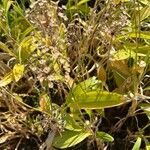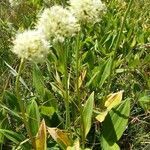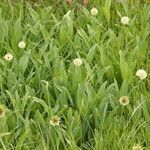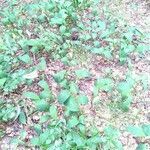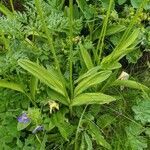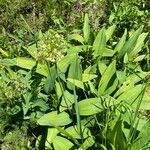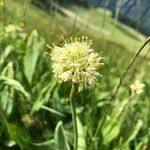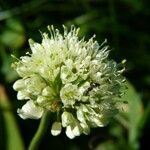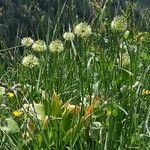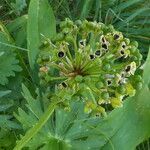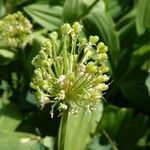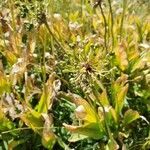Bulbs 1–several, attached to ± oblique rhizome, cylindric-conic, 5–6 × 1–2 cm; outer coats enclosing 1 or more bulbs, light brown to grayish brown, reticulate, cells fine-meshed, open, ± fibrous; inner coat white to light brown, not appearing cellular, 10–18-veined, veins prominent, parallel. Leaves persistent, green at anthesis, 2–3, sheathing proximal 1/3–1/2 scape; blade solid, flat, narrowly lanceolate to broadly elliptic, 10–20 cm × 15–90 mm, base evidently petiolate, margins entire; petiole 1–20 cm. Scape persistent, solitary, erect, terete distally, 2-edged proximally, 30–70 cm × 2–3 mm. Umbel persistent, erect, loose, 20–35-flowered, hemispheric, bulbels unknown; spathe bracts persistent, 1–2, 3–6-veined, lanceolate to ovate, ± equal, apex obtuse, nearly beakless. Flowers stellate, 4–5 mm; tepals spreading, white or greenish white, outer lanceolate, inner narrowly ovate, ± equal, reflexed in age, withering in fruit, margins entire, apex acute or obtuse; stamens exserted; anthers yellow; pollen yellow; ovary crestless; style exserted, linear, equaling stamens or longer; stigma capitate, scarcely thickened; pedicel 10–30 mm. Seed coat not known.
More
Bulb solitary or clustered, subcylindric; tunic grayish brown to blackish brown, reticulate. Leaves 2 or 3; petiole 2--10 cm; leaf blade oblanceolate-elliptic to elliptic, 8--12 × 3--9.5 cm, base cuneate to broadly so, gradually narrowed into petiole, decurrent, apex acute or acuminate. Scape 25--80 cm, terete, covered with leaf sheaths for 1/4--1/2 its length. Spathe 2-valved, persistent. Umbel globose. Pedicels 2--4 × as long as perianth, ebracteolate. Perianth white or slightly tinged with green, very rarely tinged with red; outer segments boat-shaped, 4--5 × 1.5--2 mm, apex obtuse; inner ones elliptic-ovate, (4.5--)5--6 × 2--3 mm, apex obtuse, usually denticulate. Filaments 1.3--2 × as long as perianth segments, connate at base and adnate to perianth segments; outer ones subulate; inner ones narrowly triangular, wider, 1--1.5 mm wide at base. Ovary constricted at base into a stipe ca. 1 mm; ovules 1 per locule. Fl. and fr. Jun--Aug. 2 n = 16, 32*.
An onion family plant. It is a bulb plant. There can be one bulb or a cluster. The covering is greyish-brown. There are 2-3 leaves. The leaf stalk is 2-10 cm long and the leaf blade is 8-12 cm long by 3-9.5 cm wide. The base is wedge shaped narrowing into the leaf stalk. It tapers to the tip.
Rocky and stony places in mountains, usually on calcareous soils. Forests, shady and moist slopes, pastures and streamsides at elevations from 600-2,500 metres in China.
More
It is a temperate plant. It grows in forests and shady moist places near streams between 600-2500 m altitude in N China. In Sichuan.
Can be grown by divisions or seedlings. Seeds needs stratification.
